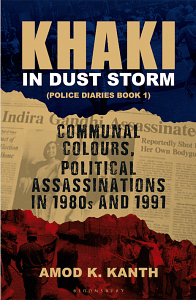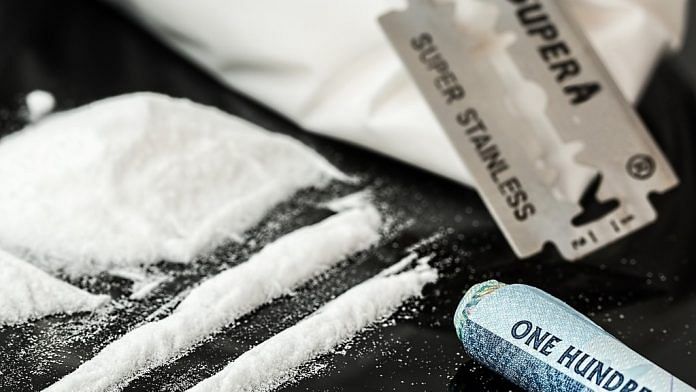I looked after the anti-narcotics section of the Crime Branch for nearly five years (1985–1990) during my tenure as Deputy Commissioner of Police Crime and Railways in Delhi Police.
Considering the deadly impact of drugs on children and the youth, the new NDPS Act, 1985, was enforced. It culminated in our action-based marathon study on 5,834 drug peddlers and abusers which the Research Cell of Delhi Police under my charge conducted at that time.
Drug trafficking was already on the rise in the first half of the 1980s in and around Delhi, particularly heroin, popularly called smack. The union government as well as Delhi Police took up the challenge of controlling drug- based crimes very seriously. The situation had become grim with rampant drug abuse and drug-based crimes.
Also read: New book traces tumultuous 1980s and ’90s through the life of a police officer
Delhi and many other cities of India, particularly those bordering north-west India, like in Punjab, Jammu and Kashmir and Rajasthan, North-east India and, to some extent, the coastal areas of Kerala, Andhra Pradesh and Tamil Nadu, were under the terrible impact of drug trafficking and drug-based crimes in the early 1980s.
The study of our Crime Branch research team revealed crucial findings that helped not only the police and the central government who started taking a holistic view of the problem but also journalists, academicians and students who were greatly enlightened by them. It helped the government prepare an action plan and the Narcotics Bureau as the apex body to set its strategies against drug traffickers and drug abusers.
Large-scale efforts were made in the second half of the 1980s and early 1990s to curb drug abuse in Delhi and some other endemic areas. The efforts made by various agencies including Delhi Police arguably saved India from becoming the worst victim of this menace.
I recall some names of policemen who had proved to be anti-drug operatives of outstanding skill. However, one peculiarity I now recall being typical with one or two of them was that those extraordinary policemen at one point of time themselves got enslaved by the habit of illicit drugs and their personal lives were terribly harmed.
Ironically, it is a man-made disaster which is personalised, driven by desire, creating demand and supply and resulting in the largest organised crime. Drug abuse and drug addiction involving small-time peddling are crimes that appear different from drug trafficking, but they are all deeply interlinked, which, as police officers we had to deal with at different levels.
Also read: As NCB continues arrests, India votes at UN to declare cannabis a less dangerous drug
The Golden Crescent is a geographical space covering largely Afghanistan with Pakistan and Iran in Asia, which is connected to India more directly and also deviously mixed up with insurgency and secessionism. While the Golden Triangle was the hub of illicit drug trade in the Cold War period till the turn of the century, the Golden Crescent became the fulcrum of major illicit drug cultivation and trade from about the beginning of the 21st century.
It is not difficult to understand that India’s precarious location on the drugs map, coupled with thousands of kilometres bordering Nepal and our own huge opium and cannabis cultivations, makes it extremely vulnerable to both these geographical settings. The entire North-east India gets affected by the Golden Triangle and similarly the border states of the north-west, like Punjab, Jammu & Kashmir and Rajasthan get affected by the Golden Crescent, which has remained the supply source for Delhi as well.
Delhi got affected by both kinds of drug-based crimes. During my time at the Crime Branch, Delhi’s cocaine supply chain was connected with Colombia, Peru and Chile.
Another reason was the waning of the superpowers and the fall of the communists, especially USSR and China, after the Cold War, who by then had started relinquishing their command over such areas and aligning with liberal forces for treading on the path of capitalist economy.
In Myanmar, bodies like the United Wa State Army (UWSA) or Myanmar Oil and Gas Enterprise (MOGE), all run by the State, and deeply enmeshed in illicit drug trade, had started withdrawing. International drug lords like the Chinese Khun Sa of Myanmar had slowed down. At the same time, the Golden Crescent had been picking up, by the mid-1990s.
Afghanistan is one of the most important opium-producing centres of the world. With a huge influx of Afghan refugees, Delhi felt the impact of this terrible situation.
A large number of laboratories for processing heroin came up along the Pakistan–Afghanistan border. When law enforcement became extremely strict against drug trafficking in Iran after the 1979 Iranian Revolution, the traffickers found it difficult to operate from Iran and took up the route of India via Pakistan. This was politically convenient for Pakistan. Hence, it encouraged this trend rather than blocking it.
The seizures increased during our times due to three reasons. We had laws to provide back-up, we had the accurate information and we could work as a team for raids, searches and investigations. Our efforts climaxed in the 1990s, and drug trafficking via Delhi got controlled to a large extent. Though India as a whole and Delhi in particular was saved from becoming another Colombia, it remained vulnerable to drug smugglers.
As a policeman, I have always felt that drug- based crime and abuse are deeply connected with illegal international trade of sophisticated arms and ammunition, terrorism, flesh trade and even AIDS. Superpowers of the West used it all for their imperialistic designs. To sustain their own economy or to exploit and empty the other world of its resources or to curb a threat to their supremacy and sovereignty, the superpowers infused and gave impetus to this malaise wherever they felt the need to do so: in Latin America, South Asia, Far East Asia, the Middle East, African countries and India.
China resisted the British narco-imperialism and the two infamous opium wars were fought during 1839–1860 on its land, which became the precursor to a somewhat similar form of imperialism in India that has since persisted in its impact.
A number of historians and economists have drawn on the concept of the drain of wealth from India through the opium trade imposed over the fertile lands of Bihar, UP and Jharkhand. Research shows that the State-run extraction of opium rents caused permanent damage to socio-economic set-ups causing gross under- development in the entire region. The damage was so severe that even today many areas lag behind the rest of the country in terms of income, literacy and access to public goods.
Not only this, there is evidence that the ISI of Pakistan also indulged in drug trade to spread terrorism all over India. The smuggling of illegal arms, ammunitions and explosives from Pakistan is often found to be mixed with smuggling of illicit drugs into India. The Taliban Mujahideen and ISI-backed intruders in Kashmir brought in with them narcotics which were often used for financing the Kashmir operations of the terrorists.
During Rajiv Gandhi’s assassination investigation, I got to know that on the Tamil Nadu coast Vedaranyam, just 40 kilometres from Point Pedro in Jaffna, the flow of drugs and arms had been going on and LTTE-related narco-terrorism had also been manifesting in several incidents in India.
In the North-east, while serving as DIG in Mizoram and DGP in Arunachal Pradesh, I had ample material in hand to suggest that fomented by insurgency and concomitant violence and disruption, the drug situation became quite grim with a burgeoning number of drug addicts and later the scourge of HIV/AIDS transmitted through drug injections.
Coming back to the problem of drugs in the national capital, a total of 5,834 persons were arrested by us in Delhi Police during the period of the study. The district-wise figures were 1507 in North, 2,252 in Central, 554 in East, 257 in New Delhi, 623 in West district, 401 in South and 240 in the Delhi Railway Police and Palam Airport Police. The arrested persons were drug abusers, including drug addicts, big and small traffickers and peddlers. They were a mix of students, homeless people, frustrated, jobless and depressed citizens from all sections of the society.
Also read: Why India needs to re-look at messy drug laws, and not go for ‘Bollywood clean-up’
One reason was that there are easy and protected hideouts in the walled city where it is not easy for the police to approach due to the complex network of narrow lanes and alleys with thousands of people living in congested houses built at no distance from each other. Apart from the Central district, a big hub of illicit drug trade was in the Seemapuri area of East Delhi and Tilak Nagar in West Delhi. Since we had experts of these areas in the police force, the moment our mission began, these hubs began to disperse to other areas.
I remember that one decision taken was to concentrate on peddlers rather than stray addicts because the former could give clues to the bigger networks of the illicit trade. A surprising observation made during the analysis was that a good number of peddlers were not addicts, though in Delhi addict-peddlers were the phenomenon. There were some peddlers who had never taken any drug and were just doing drug smuggling as an occupation. Of the 5,834 persons arrested during that period, 4,365 were found to be pure addicts. The study clearly showed that there were 1,469 persons who were just peddlers and not drug users.
The NDPS Act, 1985, and the NCB headed by the veteran B.V. Kumar of Indian Revenue Service helped us tremendously in our war against drugs. It was quite a coincidence that Ranjit Hotel near the walled city which used to be a haven of illicit drugs business was converted into the NCB headquarters.

This excerpt of Khaki in Dust Storm has been published with permission from Bloomsbury, and will be launched on 19 December on ThePrint’s SoftCover.







The problem of your report on your own war on drugs is that you used as a reference countries that you really do not know like Colombia. So disturbing that a country like Colombia is used in so gloomy way. Visit Colombia and know what is behind the war on drugs there, then you can compare the reality of war on drugs in India. Research does not come out from assumptions. Colombia and India are very much different countries and it includes their problem on drugs.